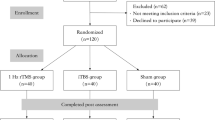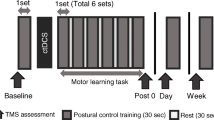Abstract
Spinocerebellar ataxia (SCA) results in balance and coordination impairment, and current treatments have limited efficacy. Recent evidence suggests that combining postural training with cerebellar transcranial direct current stimulation (ctDCS) can improve these symptoms. However, the combined effects of ctDCS and postural training on individuals with spinocerebellar ataxia remain underexplored. Ten volunteers with (SCA type 3) participated in a triple-blind, randomized, crossover study to receive a single session of ctDCS (2 mA for 20 min) and a sham ctDCS session separated by at least one week. The Biodex Balance System was used to assess balance at each session, measuring overall stability index, anteroposterior stability index, and medial-lateral stability index. As secondary outcomes, cerebellar ataxia symptoms were evaluated using the 8-item Scale for Assessment and Rating of Ataxia. The assessments were conducted before and after each session. The results indicated that ctDCS enhanced the overall stability index when compared to sham ctDCS (Z = -2.10, p = 0.03), although it did not significantly affect the anteroposterior or medial-lateral stability indices. Compared to the baseline, a single session of ctDCS reduced appendicular symptoms related to cerebellar ataxia, as evidenced by improvements in the nose-finger test (Z = -2.07, p = 0.04), fast alternating hand movements (Z = -2.15, p = 0.03), and heel-to-shin slide (Z = -1.91, p = 0.05). In conclusion, our study suggests that a single session of ctDCS, in combination with postural training, can enhance balance and alleviate ataxia symptoms in individuals with cerebellar ataxia. This study was approved by the local research ethics committee (No. 2.877.813) and registered on clinicaltrials.org (NCT04039048 - https://www.clinicaltrials.gov/study/NCT04039048) on 2019-07-28.




Similar content being viewed by others
Data Availability
No datasets were generated or analysed during the current study.
References
Katagiri N, Kawakami S, Okuyama S, Koseki T, Kudo D, Namba S, et al. Single-session cerebellar transcranial direct current stimulation affects postural control learning and cerebellar brain inhibition in healthy individuals. Cerebellum. 2021;20:203–11.
Benussi A, Dell’Era V, Cotelli MS, Turla M, Casali C, Padovani A, et al. Long term clinical and neurophysiological effects of cerebellar transcranial direct current stimulation in patients with neurodegenerative ataxia. Brain Stimul. 2017;10:242–50.
Benussi A, Koch G, Cotelli M, Padovani A, Borroni B. Cerebellar transcranial direct current stimulation in patients with ataxia: a double-blind, randomized, sham-controlled study. Mov Disord. 2015;30:1701–5.
Benussi A, Dell’Era V, Cantoni V, Bonetta E, Grasso R, Manenti R, et al. Cerebello-spinal tDCS in ataxia: a randomized, double-blind, sham-controlled, crossover trial. Neurology. 2018;91:e1090–101.
Ferrucci R, Marceglia S, Vergari M, Cogiamanian F, Mrakic-Sposta S, Mameli F, et al. Cerebellar transcranial direct current stimulation impairs the practice-dependent proficiency increase in working memory. J Cogn Neurosci. 2008;20:1687–97.
Galea JM, Jayaram G, Ajagbe L, Celnik P. Modulation of cerebellar excitability by polarity-specific noninvasive direct current stimulation. J Neurosci. 2009;29:9115–22.
Grimaldi G, Argyropoulos GP, Bastian A, Cortes M, Davis NJ, Edwards DJ, et al. Cerebellar transcranial direct current stimulation (ctDCS): a novel approach to understanding cerebellar function in health and disease. Neuroscientist. 2016;22:83–97.
Ugawa Y, Uesaka Y, Terao Y, Hanajima R, Kanazawa I. Magnetic stimulation over the cerebellum in humans. Ann Neurol. 1995;37:703–13.
Ferrucci R, Brunoni AR, Parazzini M, Vergari M, Rossi E, Fumagalli M, et al. Modulating human procedural learning by cerebellar transcranial direct current stimulation. Cerebellum. 2013;12:485–92.
Poortvliet P, Hsieh B, Cresswell A, Au J, Meinzer M. Cerebellar transcranial direct current stimulation improves adaptive postural control. Clin Neurophysiol. 2018;129:33–41.
Yosephi MH, Ehsani F, Zoghi M, Jaberzadeh S. Multi-session anodal tDCS enhances the effects of postural training on balance and postural stability in older adults with high fall risk: primary motor cortex versus cerebellar stimulation. Brain Stimul. 2018;11:1239–50.
Mendonça MS, Goulardins JB, Souza C, de O, Monte- Silva K, Tanaka C. Aplicação simultânea de estimulação transcraniana por corrente contínua cerebelar anódica para reabilitação do equilíbrio na ataxia cerebelar: relato de caso. Rev Pesqui em Fisioter. 2021;11:427–34.
Nitsche MA, Cohen LG, Wassermann EM, Priori A, Lang N, Antal A, et al. Transcranial direct current stimulation: state of the art 2008. Brain Stimul. 2008;1:206–23.
Arnold BL, Schmitz RJ. Examination of balance measures produced by the biodex stability system. J Athl Train. 1998;33:323–7.
Schmitz-Hübsch T, du Montcel ST, Baliko L, Berciano J, Boesch S, Depondt C, et al. Scale for the assessment and rating of ataxia: development of a new clinical scale. Neurology. 2006;66:1717–20.
Schober P, Boer C, Schwarte LA. Correlation coefficients: appropriate use and interpretation. Anesth Analg. 2018;126:1763–8.
Takakusaki K. Functional neuroanatomy for posture and gait control. J Mov Disord. 2017;10:1–17.
Ivanenko Y, Gurfinkel VS. Human postural control. Front Neurosci. 2018;12:171.
Woollacott MH, Shumway-Cook A, Nashner LM. Aging and posture control: changes in sensory organization and muscular coordination. Int J Aging Hum Dev. 1986;23:97–114.
Behrens M, Mau-Moeller A, Lischke A, Katlun F, Gube M, Zschorlich V, et al. Mental fatigue increases gait variability during dual-task walking in old adults. J Gerontol Biol Sci Med Sci. 2018;73:792–7.
Brahms M, Heinzel S, Rapp M, Mückstein M, Hortobágyi T, Stelzel C, et al. The acute effects of mental fatigue on balance performance in healthy young and older adults - a systematic review and meta-analysis. Acta Psychol. 2022;225:103540.
Nardone A, Tarantola J, Giordano A, Schieppati M. Fatigue effects on body balance. Electroencephalogr Clin Neurophysiol. 1997;105:309–20.
Malek N, Makawita C, Al-Sami Y, Aslanyan A, de Silva R. A systematic review of the spectrum and prevalence of non-motor symptoms in adults with hereditary cerebellar ataxias. Mov Disord Clin Pract. 2022;9:1027–39.
Martinez ARM, Nunes MB, Faber I, D’Abreu A, Lopes-Cendes Í, França MC Jr. Fatigue and its associated factors in spinocerebellar ataxia type 3/Machado-Joseph disease. Cerebellum. 2017;16:118–21.
Brusse E, Brusse-Keizer MGJ, Duivenvoorden HJ, van Swieten JC. Fatigue in spinocerebellar ataxia: patient self-assessment of an early and disabling symptom. Neurology. 2011;76:953–9.
Gorniak SL. The relationship between task difficulty and motor performance complexity. Atten Percept Psychophys. 2019;81:12–9.
Singer RN, Gerson RF. Task classification and strategy utilization in motor skills. Res Q Exerc Sport. 1981;52:100–16.
MacLullich AMJ, Edmond CL, Ferguson KJ, Wardlaw JM, Starr JM, Seckl JR, et al. Size of the neocerebellar vermis is associated with cognition in healthy elderly men. Brain Cogn. 2004;56:344–8.
Casamento-Moran A, Mooney RA, Chib VS, Celnik PA. Cerebellar excitability regulates physical fatigue perception. J Neurosci. 2023;43:3094–106.
Ludlow CL. Central nervous system control of voice and swallowing. J Clin Neurophysiol. 2015;32:294–303.
Grimaldi G, Manto M. Anodal transcranial direct current stimulation (tDCS) decreases the amplitudes of long-latency stretch reflexes in cerebellar ataxia. Ann Biomed Eng. 2013;41:2437–47.
Maas RPPWM, Teerenstra S, Toni I, Klockgether T, Schutter DJLG, van de Warrenburg BPC. Cerebellar transcranial direct current stimulation in spinocerebellar ataxia type 3: a randomized, double-blind, sham-controlled trial. Neurotherapeutics. 2022;19:1259–72.
Mitoma H, Buffo A, Gelfo F, Guell X, Fucà E, Kakei S et al. Consensus paper. Cerebellar reserve: from cerebellar physiology to cerebellar disorders. The Cerebellum. 2020:131–53. https://doi.org/10.1007/s12311-019-01091-9
Mitoma H, Manto M, Hampe CS. Time is cerebellum. Cerebellum. 2018;17:387–91.
Tezenas du Montcel S, Petit E, Olubajo T, Faber J, Lallemant-Dudek P, Bushara K, et al. Baseline clinical and blood biomarkers in patients with preataxic and early-stage disease spinocerebellar ataxia 1 and 3. Neurology. 2023;100:e1836–48.
Nuttall FQ. Body mass index: obesity, BMI, and health: a critical review. Nutr Today. 2015;50:117–28.
Diallo A, Jacobi H, Schmitz-Hübsch T, Cook A, Labrum R, Durr A, et al. Body mass index decline is related to spinocerebellar ataxia disease progression. Mov Disord Clin Pract. 2017;4:689–97.
Yang J-S, Chen P-P, Lin M-T, Qian M-Z, Lin H-X, Chen X-P, et al. Association between body mass index and disease severity in chinese spinocerebellar ataxia type 3 patients. Cerebellum. 2018;17:494–8.
Roeske S, Filla I, Heim S, Amunts K, Helmstaedter C, Wüllner U, et al. Progressive cognitive dysfunction in spinocerebellar ataxia type 3. Mov Disord. 2013;28:1435–8.
Benussi A, Cantoni V, Manes M, Libri I, Dell’Era V, Datta A, et al. Motor and cognitive outcomes of cerebello-spinal stimulation in neurodegenerative ataxia. Brain. 2021;144:2310–21.
Acknowledgements
We thank the patients for their commitment to the study.
Funding
this research was supported by grant (nº 310369/2022-3) from Conselho Nacional de Desenvolvimento Científico e Tecnológico (CNPq), and in part by the Coordenação de Aperfeiçoamento de Pessoal de Nível Superior – Brasil (CAPES) – Finance Code 001. Kátia Monte-Silva is supported by CNPq/Brazil (Grant No.310369/2022-3).
Author information
Authors and Affiliations
Contributions
RB, AB, and KMS designed the study. RB, JVF, and KMS conducted the literature search and extracted the information. RB evaluated the volunteers. JVF and AA performed the interventions on the volunteers. RB, GB, and KMS analyzed the data. RB and KMS drafted the manuscript. All the authors reviewed and approved the manuscript.
Corresponding author
Ethics declarations
Ethics Approval
This study was approved by the local research ethics committee (No. 2.877.813), registered at clinicaltrials.org (NCT04039048), and performed according to the Declaration of Helsinki.
Consent to Participate
informed consent was obtained from all individual participants included in the study.
Consent for Publication
The authors affirm that human research participants provided informed consent for publication of the images in Fig. 2.
Competing Interests
The authors declare no competing interests.
Additional information
Publisher’s Note
Springer Nature remains neutral with regard to jurisdictional claims in published maps and institutional affiliations.
Rights and permissions
Springer Nature or its licensor (e.g. a society or other partner) holds exclusive rights to this article under a publishing agreement with the author(s) or other rightsholder(s); author self-archiving of the accepted manuscript version of this article is solely governed by the terms of such publishing agreement and applicable law.
About this article
Cite this article
Brito, R., Fabrício, J.V., Araujo, A. et al. Single-Session Cerebellar Transcranial Direct Current Stimulation Improves Postural Stability and Reduces Ataxia Symptoms in Spinocerebellar Ataxia. Cerebellum (2024). https://doi.org/10.1007/s12311-024-01696-9
Accepted:
Published:
DOI: https://doi.org/10.1007/s12311-024-01696-9




